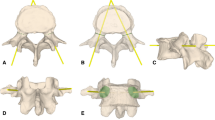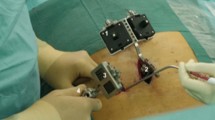Abstract
Purpose
Augmented reality (AR) enables superimposition of virtual images onto the real world. The aim of this study is to present a novel AR-based navigation system for sacroiliac screw insertion and to evaluate its feasibility and accuracy in cadaveric experiments.
Methods
Six cadavers with intact pelvises were employed in our study. They were CT scanned and the pelvis and vessels were segmented into 3D models. The ideal trajectory of the sacroiliac screw was planned and represented visually as a cylinder. For the intervention, the head mounted display created a real-time AR environment by superimposing the virtual 3D models onto the surgeon’s field of view. The screws were drilled into the pelvis as guided by the trajectory represented by the cylinder. Following the intervention, a repeat CT scan was performed to evaluate the accuracy of the system, by assessing the screw positions and the deviations between the planned trajectories and inserted screws.
Results
Post-operative CT images showed that all 12 screws were correctly placed with no perforation. The mean deviation between the planned trajectories and the inserted screws was 2.7 ± 1.2 mm at the bony entry point, 3.7 ± 1.1 mm at the screw tip, and the mean angular deviation between the two trajectories was 2.9° ± 1.1°. The mean deviation at the nerve root tunnels region on the sagittal plane was 3.6 ± 1.0 mm.
Conclusions
This study suggests an intuitive approach for guiding screw placement by way of AR-based navigation. This approach was feasible and accurate. It may serve as a valuable tool for assisting percutaneous sacroiliac screw insertion in live surgery.





Similar content being viewed by others
References
Shuler TE, Boone DC, Gruen GS, Peitzman AB (1995) Percutaneous iliosacral screw fixation: early treatment for unstable posterior pelvic ring disruptions. J Trauma 38:453–458
Routt ML Jr, Kregor PJ, Simonian PT, Mayo KA (1995) Early results of percutaneous iliosacral screws placed with the patient in the supine position. J Orthop Trauma 9:207–214
Yu X, Tang M, Zhou Z, Peng X, Wu T, Sun Y (2013) Minimally invasive treatment for pubic ramus fractures combined with a sacroiliac joint complex injury. Int Orthop 37:1547–1554. doi:10.1007/s00264-013-1954-x
Peng KT, Li YY, Hsu WH, Wu MH, Yang JT, Hsu CH, Huang TJ (2013) Intraoperative computed tomography with integrated navigation in percutaneous iliosacral screwing. Injury 44:203–208. doi:10.1016/j.injury.2012.09.017
Hinsche AF, Giannoudis PV, Smith RM (2002) Fluoroscopy-based multiplanar image guidance for insertion of sacroiliac screws. Clin Orthop Relat Res 135–144
Templeman D, Schmidt A, Freese J, Weisman I (1996) Proximity of iliosacral screws to neurovascular structures after internal fixation. Clin Orthop Relat Res 194–198
Xu P, Wang H, Liu ZY, Mu WD, Xu SH, Wang LB, Chen C, Cavanaugh JM (2013) An evaluation of three-dimensional image-guided technologies in percutaneous pelvic and acetabular lag screw placement. J Surg Res 185:338–346. doi:10.1016/j.jss.2013.05.074
Grossterlinden L, Rueger J, Catala-Lehnen P, Rupprecht M, Lehmann W, Rucker A, Briem D (2011) Factors influencing the accuracy of iliosacral screw placement in trauma patients. Int Orthop 35:1391–1396. doi:10.1007/s00264-010-1092-7
Gras F, Marintschev I, Klos K, Muckley T, Hofmann GO, Kahler DM (2012) Screw placement for acetabular fractures: which navigation modality (2-dimensional vs. 3-dimensional) should be used? An experimental study. J Orthop Trauma 26:466–473. doi:10.1097/Bot.0b013e318234d443
Wahnert D, Raschke MJ, Fuchs T (2013) Cement augmentation of the navigated iliosacral screw in the treatment of insufficiency fractures of the sacrum. A new method using modified implants. Int Orthop 37:1147–1150. doi:10.1007/s00264-013-1875-8
Arand M, Kinzl L, Gebhard F (2004) Computer-guidance in percutaneous screw stabilization of the iliosacral joint. Clin Orthop Relat Res 201–207. doi:10.1097/01.blo.0000128644.46013.08
Takao M, Nishii T, Sakai T, Yoshikawa H, Sugano N (2014) Iliosacral screw insertion using CT-3D-fluoroscopy matching navigation. Inj Int J Care Inj 45:988–994. doi:10.1016/j.injury.2014.01.015
Vigh B, Muller S, Ristow O, Deppe H, Holdstock S, den Hollander J, Navab N, Steiner T, Hohlweg-Majert B (2014) The use of a head-mounted display in oral implantology: a feasibility study. Int J Comput Assist Radiol Surg 9:71–78. doi:10.1007/s11548-013-0912-9
Besharati Tabrizi L, Mahvash M (2015) Augmented reality-guided neurosurgery: accuracy and intraoperative application of an image projection technique. J Neurosurg 1–6. doi:10.3171/2014.9.JNS141001
Kang X, Azizian M, Wilson E, Wu K, Martin AD, Kane TD, Peters CA, Cleary K, Shekhar R (2014) Stereoscopic augmented reality for laparoscopic surgery. Surg Endosc 28:2227–2235. doi:10.1007/s00464-014-3433-x
Qu M, Hou Y, Xu Y, Shen C, Zhu M, Xie L, Wang H, Zhang Y, Chai G (2015) Precise positioning of an intraoral distractor using augmented reality in patients with hemifacial microsomia. J Cranio-Maxillofac Surg: Off Publ Eur Assoc Cranio-Maxillofac Surg 43:106–112. doi:10.1016/j.jcms.2014.10.019
Suenaga H, Hoang Tran H, Liao H, Masamune K, Dohi T, Hoshi K, Mori Y, Takato T (2013) Real-time in situ three-dimensional integral videography and surgical navigation using augmented reality: a pilot study. Int J Oral Sci 5:98–102. doi:10.1038/ijos.2013.26
Abe Y, Sato S, Kato K, Hyakumachi T, Yanagibashi Y, Ito M, Abumi K (2013) A novel 3D guidance system using augmented reality for percutaneous vertebroplasty: technical note. J Neurosurg Spine 19:492–501. doi:10.3171/2013.7.spine12917
Chen X, Xu L, Wang Y, Wang H, Wang F, Zeng X, Wang Q, Egger J (2015) Development of a surgical navigation system based on augmented reality using an optical see-through head-mounted display. J Biomed Inform 55:124–131. doi:10.1016/j.jbi.2015.04.003
Smith HE, Yuan PS, Sasso R, Papadopolous S, Vaccaro AR (2006) An evaluation of image-guided technologies in the placement of percutaneous iliosacral screws. Spine 31:234–238
Wong JM, Bewsher S, Yew J, Bucknill A, de Steiger R (2015) Fluoroscopically assisted computer navigation enables accurate percutaneous screw placement for pelvic and acetabular fracture fixation. Injury 46:1064–1068. doi:10.1016/j.injury.2015.01.038
Zwingmann J, Konrad G, Kotter E, Sudkamp NP, Oberst M (2009) Computer-navigated iliosacral screw insertion reduces malposition rate and radiation exposure. Clin Orthop Relat Res 467:1833–1838. doi:10.1007/s11999-008-0632-6
Routt ML Jr, Simonian PT, Mills WJ (1997) Iliosacral screw fixation: early complications of the percutaneous technique. J Orthop Trauma 11:584–589
Rolland JP, Fuchs H (2000) Optical versus video see-through mead-mounted displays in medical visualization. Presence Teleop Virt 9:287–309. doi:10.1162/105474600566808
Shuhaiber JH (2004) Augmented reality in surgery. Arch Surg 139:170–174. doi:10.1001/archsurg.139.2.170
Acknowledgments
This work is supported by the National Natural Science Foundation of China (Grant numbers: 81272002, 81171429, and 81511130089), Biomedical Engineering Cross of Shanghai Jiao Tong University (Grant number: YG2012MS18) and the School of Medicine, Shanghai Jiao Tong University (Medical Education Grant).
Author information
Authors and Affiliations
Corresponding authors
Ethics declarations
Conflicts of interest
The authors declare no conflict of interest.
Human and animal studies
This study did not engage in the use of animals or living persons.
Additional information
Huixiang Wang and Fang Wang contributed equally to this work.
Rights and permissions
About this article
Cite this article
Wang, H., Wang, F., Leong, A.P.Y. et al. Precision insertion of percutaneous sacroiliac screws using a novel augmented reality-based navigation system: a pilot study. International Orthopaedics (SICOT) 40, 1941–1947 (2016). https://doi.org/10.1007/s00264-015-3028-8
Received:
Accepted:
Published:
Issue Date:
DOI: https://doi.org/10.1007/s00264-015-3028-8




